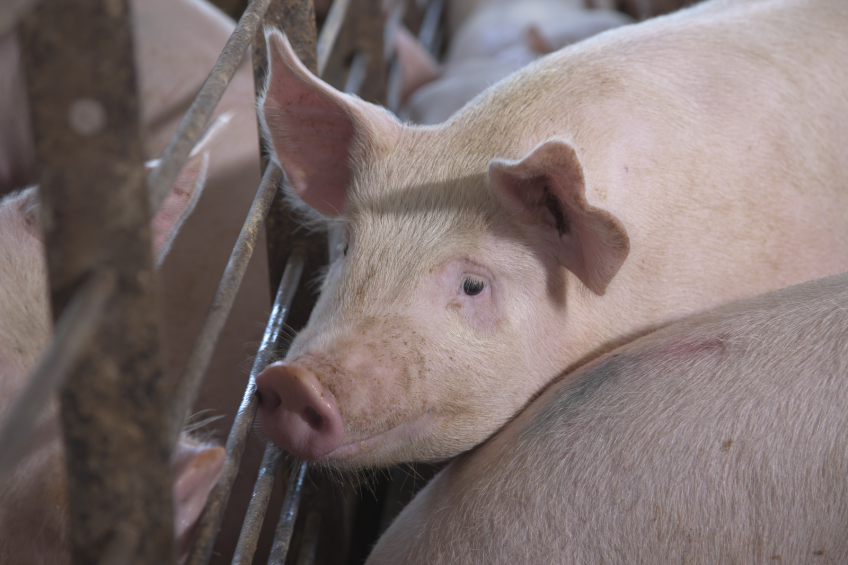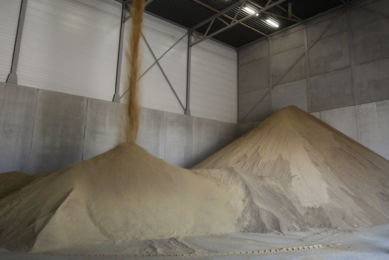Identifying problems in the pre-fattening period

The importance of weaning is undisputed. But what about that other big transfer in a pig’s life – from nursery to grow-finish floor? A successful pre-fattening period is necessary to achieve a higher percentage of lean meat and uniform carcasses at marketing.
By Dr Bradley Lawrence, swine technical manager, Novus International, United States
In pig production, the pre-fattening period can directly affect lean meat deposition and the uniformity of carcasses at marketing. This phase is the two weeks before pigs move from the nursery to the grow-finish floor.
Modelling by Dr Allan P. Schinckel at Purdue University, USA, confirms the importance of the pre-fattening period. He has found that pigs with less-than-average birth weights are less feed efficient, grow more slowly, are slightly fatter, and have a greater death loss. In addition, pigs that don’t gain well the first two weeks after weaning take longer to achieve market weight. His models of the growth and body composition of pigs are based on carcass measurements from birth to market weight. The measurements include birth and weaning weights, variance in body weight, backfat depth and percent lean.
Schinckel’s research also shows that the growth of backfat depth, loin depth, and carcass weight relative to body weight is affected by the genetics of the sire and dam lines as well as the environment. Genetically selecting for increased lean growth rates and feed efficiency has resulted in pigs with decreased rates of backfat depth growth and increased rates of loin depth growth to heavier bodyweight. Consequently, those genetic lines that maintain acceptable carcass leanness to heavier bodyweight can be more profitably marketed at heavier body weight than pigs of the past.
Fibre muscles
Dr Jeffery Escobar, senior manager of swine nutrition research at Novus International also notes, that the leaner the animal, the more susceptible it becomes to stress and inclement conditions. This is due to the animal’s higher ratio of white fibre muscles to red fibre muscles. White fibre muscles are much more susceptible to being degraded when the animal is stressed or immunologically challenged. Both of which happen when nursery pigs move from the nursery to the grower floor. In comparison, the red fibre muscle is more resilient to stress and to inflammation. Genetic selection has decreased red fibre muscle levels and increased white fibre muscle levels in today’s animals.
During the last 20-30 years, fat has been bred off of pigs. Yet, fat-soluble vitamins have an important role in helping pigs resist stress and deal with the physiological changes associated with stress and immune challenges. If a pig simply has less fat because of its genetically altered lean-to-fat ratio, then the pig also has a lower level of fat-soluble vitamins. As a result, paying attention to management items such as feed quality becomes more important along with focusing on the animal’s oxidative status during the transition phase. The bottom line is that stress hurts production. By minimising stress, more lean meat can be produced. Several potential sources of stress occur naturally in hog production systems. US producers, for instance, use either a wean-to-finish or a conventional nursery with a finisher floor. Little change in the diet occurs between the nursery and the grower floor. Diets contain corn, soybean meal, Dried Distillers Grains with Solubles (DDGS), and maybe some wheat.
Yet the transition from the nursery to the grow-finish floor is stressful due to the co-mingling and moving of pigs, introduction of new penmates, and re-establishment of the social hierarchy.
The primary issue is in mixing the animals, even though they come from the same house, according to Escobar. “Every time you mix the pigs, you have to re-establish the pattern of the social hierarchy and pigs have a very well structured dominance hierarchy. They are going to fight for a day or two until they determine who leads, who follows, and who is last. The social hierarchy establishes dominance in eating order, laying down in the pen, etc.” During the transition, feed intake disruption can, and often does, occur. The disruption affects the pig’s intestinal or enteric system. While some pigs will immediately go to the feeder and begin eating, others with weaker social skills may not eat for 24 to up-to 48 hours at the new location, not until the social hierarchy is re-established.
With the disruption of feed intake for a period of time, two things occur in the gastro-intestinal (GI) tract, according to Escobar. First, the normal barrier function in the gut is disrupted and begins to allow bacteria and/ or endotoxins to cross into the bloodstream. In addition, the GI microflora populations begin to change and the level of pathogenic bacteria may increase, which can start a potential health challenge.
Once pigs go off feed for a period of time, the tight junctions in their GI tracts are affected. In a healthy pig, the intestinal cells are tightly joined, i.e. tight junctions form a ‘skin’ layer throughout the digestive tract. The tight junctions prevent large molecules from entering the body while nutrients enter through the cells’ absorptive capabilities. When the pig is off feed for a period of time, the tight junctions begin to relax, becoming more permeable.
‘Leaky gut’ results
The gut’s content start to migrate more freely toward the blood stream. From here, the gut’s contents move throughout the body via the body’s circulatory system and can start causing a subclinical inflammatory response. The first symptom of sickness is the animal going off feed.
Secondarily, mixing animals in high densities tends to result in disease, which can seem to appear almost out of nowhere. That causes a problem. The animals are stressed by co-mingling, transportation, and the new environment. They are not very interested in eating because they are busy fighting to find out who’s going to be running the show. When changes in the GI microflora populations occur, the level of pathogenic bacteria may increase and health challenges can begin to appear.
Industry statistics help define how important the adaptation period is from the nursery through the first two weeks in the grow-finish facility. Pigs in their first two weeks on the grow-finish floor will consume about 33% more feed than during their last two weeks in the nursery. The rapidly increasing feed intake poses the risk of diarrhoea. A bacterial imbalance in the GI system can cause potential diarrhoea-causing bacteria population to grow and cause a problem.
During weeks 2-6 after movement from the nursery to the finisher, the pig’s feed intake continues to increase by about 18% every two weeks. By week six on the grow-finish floor, pigs should be consuming 86% more feed than during the last two weeks in the nursery. That makes the first weeks in the grow-finish period very important. Pigs need to get up on feed and stay on feed without enteric challenges.
Feed intake and growth rate are directly correlated. Variations in pig growth rate typically begin developing with disruptions in feed intake. From a marketing perspective, homogeneous or very uniform groups of pigs are desired. The barns empty faster, sort loss is minimised, and the operation is easier to manage. The last two weeks in the nursery and the first six to eight weeks in the grow-finish facility determine how consistent the group will be at marketing, assuming no respiratory pathogens or other group disruptions. US industry statistics indicate that sort loss, measured as cull weight can range from 2.0 to 4.0% of total market weight from a closeout group. Cull pigs can weigh on average 50-60 pounds (23-27 kg) less than the average of the market animals. In addition to and as a result of a lighter market weight, cull market pigs often have a value that can be $13-$15 per hundredweight (pig of 45 kg) less than the net value of the group. Granted cull animals will not have consumed as much feed, but their feed conversion can be much poorer and combined with the lighter weight results in a significant drag on the overall net value of a finisher group.
Overcoming challenges
Management is the primary factor that enables operations to overcome pre-fattening period challenges: Management of the pigs and the feed. Should pigs go off feed and the gut’s integrity deteriorate, issues with feed quality can hurt production. Both mycotoxins and oxidised feed can contribute to intestinal inflammation, resulting in pigs not eating optimally.
Good pre-fattening management includes several items. Done right from day one, these items will positively impact the outcome of the transition from nursery to grow-finish floor, through to marketing. This notably includes health management: Identifying and treating pigs early, and environmental management: making sure pigs are warm and dry, humidity is low, and the air exchange rate is ample.
Recommendations
- Open the feeders up during the last 7 – 10 days in the nursery so the pigs optimise feed intake before moving. When they arrive on the grow-finish floor, they will have an expanded gut, a good healthy appetite, and be ready to eat.
- The diet the last 7-10 days in the nursery and the diet the first 7-10 days on the grow-finish floor should be as similar as possible with respect to composition although the nutrient density may differ slightly. This decreases the opportunity for a feed intake interruption or instability in the gut microflora as a result of feed refusal.
- Monitor and manage ingredient quality to encourage feed intake. Pay particular attention to the quality of any supplemental fat or high-fat feed ingredients as well as feeding high quality grains free of mycotoxins.
- Strategically use organic acids with a high degree of antimicrobial activity through the water lines as the pigs transition from the nursery to the grow-finish floor.
- Consumption of the acids will help stabilise gut microflora and help avoid potential threats from pathogenic bacteria. Where management of diarrhoea in the fattening period is a concern, also utilise an appropriate level of dietary organic acids in the feed to help maintain a consistent, gut microflora.
- In addition to organic acids, use of supplemental Cu during the pre-fattening and fattening period, particularly as a highly available source such as chelated Cu, may also help promote growth and rapid feed intake. Cu has traditionally been considered to be needed in the gut for its effect. However, research with chelated Cu suggests that this may only partially be true and that providing a highly available source of Cu may be preferred for performance and environmental reasons.
- Optimise digestibility of ingredients, minimising the amount of fermentable carbohydrates and proteins in the gut through the use of phytase and non-phytase enzymes. Optimising diet digestibility serves to both optimise feed throughput (intake) and nutrient utilisation (efficiency), helping to drive growth and lean meat produced per unit of feed consumed. Optimising diet digestibility also helps deprive potential pathogenic bacteria of nutrients for their growth.
- Use either a mash diet with a slightly higher particle size or feed a pellet with a low percent of fines the first two weeks on the grow-finish floor to minimise the risk of gastric ulcers during the time when feed intake may be interrupted.
Taking these steps with the diet and feed ingredients will help bolster feed intake, protect the stability of the gut microflora and improve the availability of nutrients. It will also help pigs that are not eating well by providing more available nutrients.











